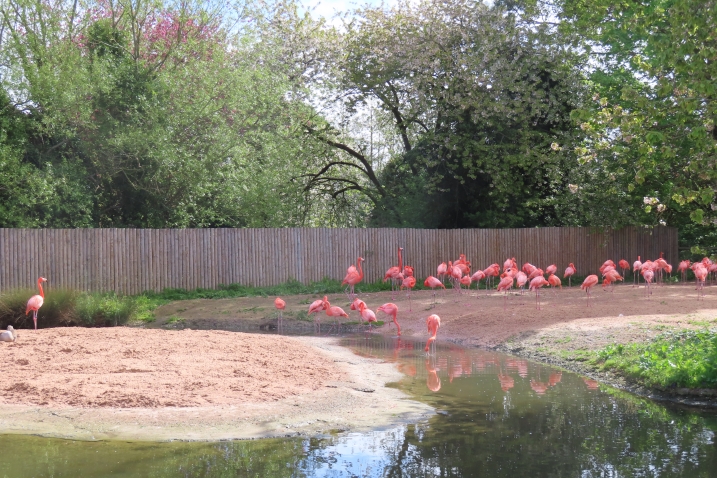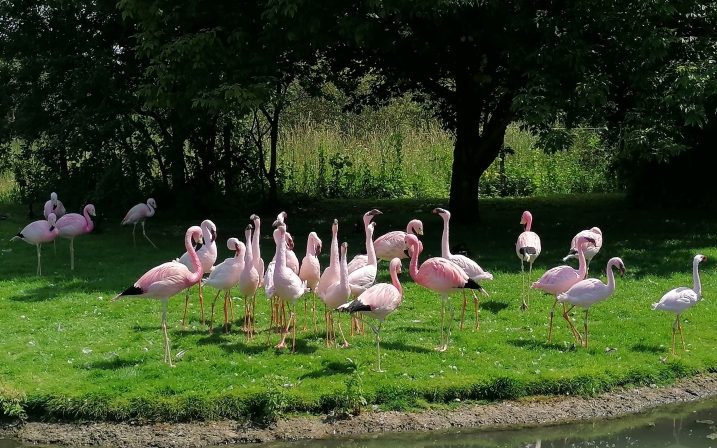Caribbean flamingos are not just for the Caribbean!
One of the most striking and flamboyant of sights at WWT Slimbridge (and at WWT Llanelli too) are the stunningly crimson Caribbean flamingos. Also know as American, Cuban or rosy flamingos, they have the scientific name Phoenicopterus ruber, which basically translates as "the red crimson wing" - aptly describing that they are as pink as pink can be! In spite of their common name, Caribbean flamingos do not solely occur across Caribbean Islands. They can also be found in Venezuela, in the Yucatan (Mexico) and occasionally in Florida, USA. And there is one further wild population of Caribbean flamingos - an unusual and remote group of birds that, some argue, should be considered a separate subspecies in their own right. These are the five-hundred-or-so Caribbean flamingos that occur in the Galapagos Islands, that famous archipelago off the coast of Ecuador in the Pacific Ocean.
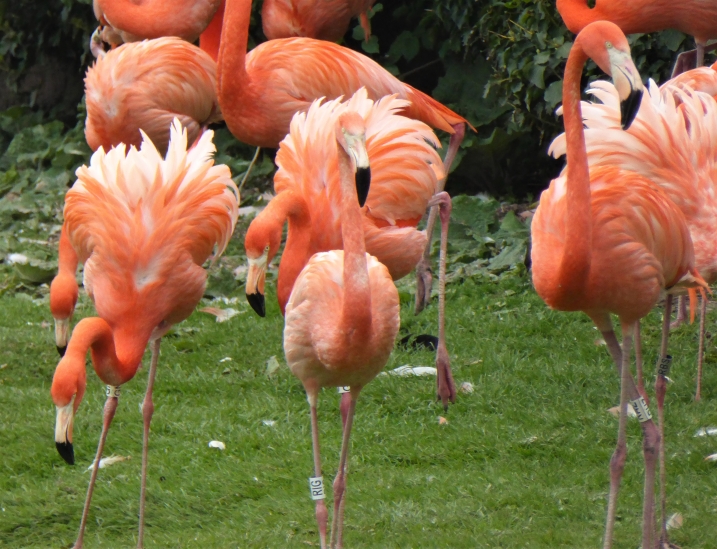
Caribbean flamingos at WWT Slimbridge in their characteristic crimson dress. Spare them an extra look next time you visit - their cousins live in some very interesting parts of the world...
In this instalment of the WWT Flamingo Diary, we will look more closely at these special birds on their distant and rugged island home. A friend of mine who works at the Adelaide Zoo has just been on a trip to South America, which included a visit to the Galapagos Islands. He was kind enough to share his flamingo photos and videos with me, and has given me his permission to include them in the Flamingo Diary.
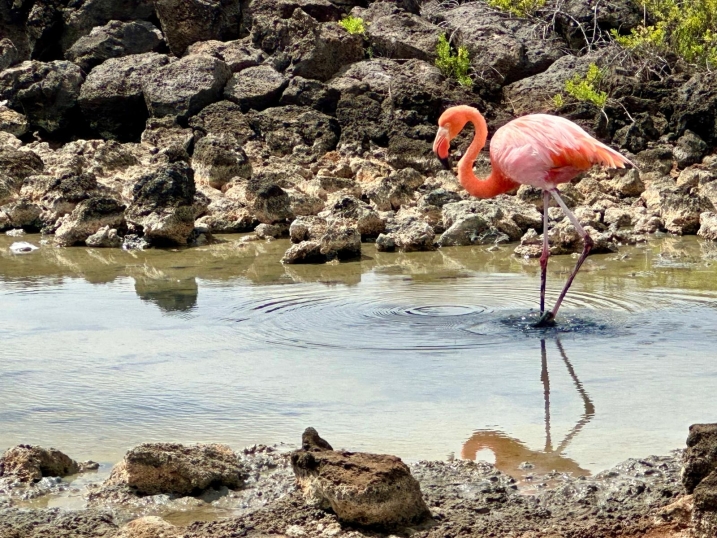
A Galapagos Caribbean flamingo in a lagoon on Floreana Island. These flamingos are often found in small groups compared to flamingos in other parts of the world, and can be more tolerant of being observed at close range. However, tourists must be careful to not unduly disturb the birds as this can disrupt their breeding and foraging behaviour. Shared with the permission of Mr Nicholas Bishop.
The flamingos in the Galapagos are predominantly found on the islands of Isabella, Floreana, Santa Cruz and Santiago - some of the largest islands in the archipelago. The islands need to have lagoons for foraging, space for courtship display and suitable, low-lying areas for nesting. The behaviour and movements of these Galapagos flamingos is heavily influenced by the weather and climate. Rainfall especially will dictate the timing of when these flamingos will nest, and climatic occurrences such as El Nino that impact on sea temperature and sea levels can impact on the suitability of feeding and foraging grounds.
The habitat of the Caribbean flamingo in the Galapagos Islands. These birds are thought to have first arrived in the Galapagos many thousands of years ago. Shared with the permission of Mr Nicholas Bishop.
Flamingos will regularly move between and within islands, depending on the suitability of habitats in each location. These movements have been widely studied, and such information can inform conservation work. For example, what areas to protect from disturbance, how to manage wetland areas for a specific behaviour (breeding, or foraging, for example), and what new habitat to create if flamingos are impacted negatively by climatic changes that alter how suitable current areas of an island is.
A flock of Caribbean flamingos takes flight over the Galapagos Island of Floreana. Whilst flamingos can move to other areas for feeding or nesting if disturbed, they only have a small number of options available to them in the Galapagos. Flamingos are not found on all Galapagos Islands and this highlights their vulnerability to habitat loss. Shared with the permission of Mr Nicholas Bishop.
There are some differences between the Caribbean flamingos that you can see at WWT Slimbridge and WWT Llanelli and the flamingos that live in the Galapagos. The Galapagos Caribbean flamingo is smaller and paler in plumage colour. The differentiation between a male flamingo and a female flamingo is much less defined in these Galapagos birds, compared to the main population of Caribbean flamingos (male flamingos are generally taller than females). They also lay smaller eggs and can nest in very small flocks (when compared to other flamingo species).

The landscape of Floreana Island is quite rugged and barren. But like most species on the Galapagos, the sea provides food and a way of living. Caribbean flamingos in the Galapagos filter feed in shallow lagoons for brine shrimp and other small crustaceans. Shared with the permission of Mr Nicholas Bishop.
It is thought that the Caribbean flamingo in the Galapagos diverged ("split away") from the main Caribbean flamingo population around 70,000 years ago. The differences in bird size, shape, behaviour and colour have lead some scientists to suggest that these Galapagos flamingo should be considered a separate subspecies (a specific type) of Caribbean flamingo with their own scientific name of Phoenicopterus ruber glyphorhynchus. However, this is not currently accepted and therefore Galapagos flamingos are included as one and the same with the "regular" Caribbean flamingo.
Social behaviour, including the start of a courtship display (birds milling around and trying to head flag) as well a flamingos foraging in a social group is most commonly seen in the months from March to August. The neck and body colour of Galapagos Caribbean flamingos is generally paler than birds outside of this population, and the shade of pink on their bill can be much lighter than on non-Galapagos individuals. Shared with the permission of Mr Nicholas Bishop.
If you would like to know more about the conservation status of the Caribbean flamingo, their wild distribution and population trend, you can find out further information on the IUCN Red List page for this species.
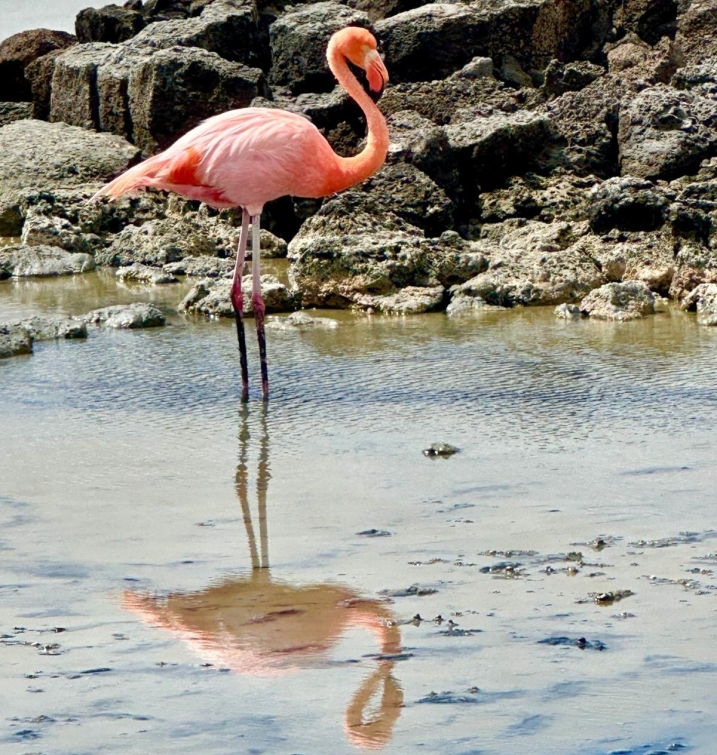
The Galapagos Caribbean flamingo is shorter (based on measures of its leg bones) and has a smaller body size than birds in the population outside of the Galapagos. Such differences may, one day, result in it being accepted that these birds are their own subspecies. Shared with the permission of Mr Nicholas Bishop.
If you would like to know more about the Galapagos population of Caribbean flamingos, then see the page on this species at the Galapagos Conservation Trust website.
I hope you enjoyed this foray into the world of this very special population of flamingos, and a big thank you to Nicholas for sharing his images and media with us all.
